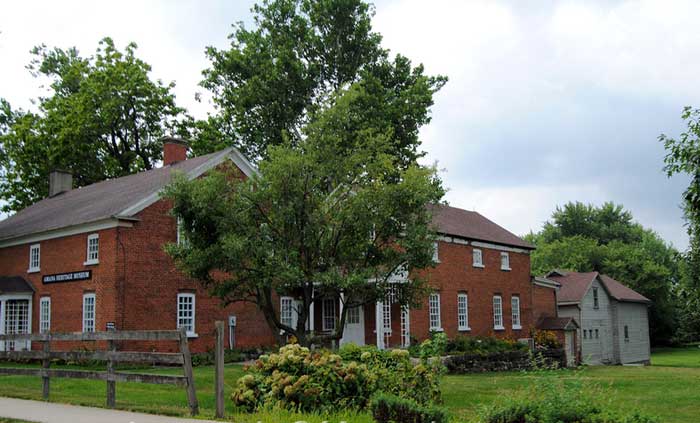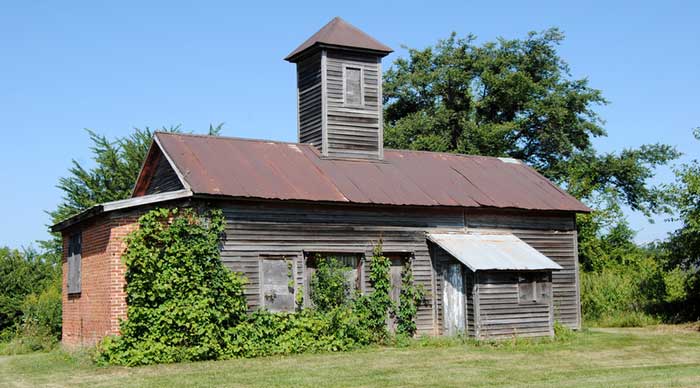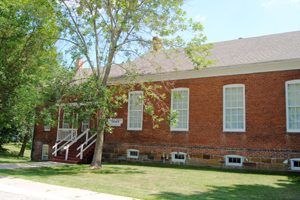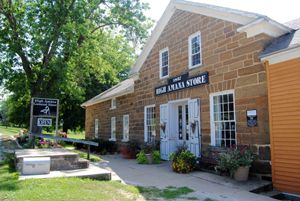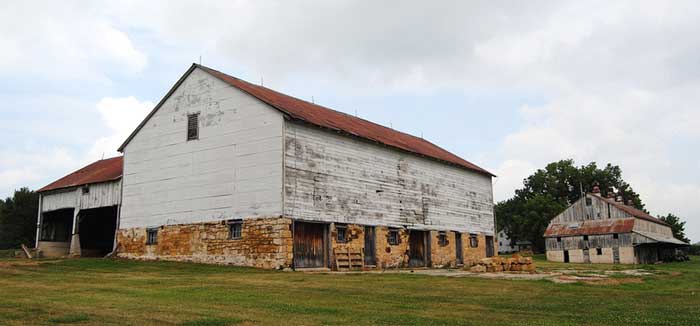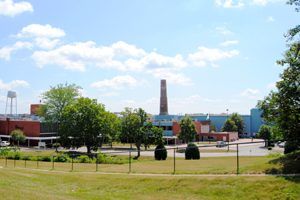The Amana Colony, a historic utopian society located in the rolling hills of Iowa’s River Valley, was established shortly before the Civil War by a group of German-speaking European settlers who belonged to a religious group known as the Community of True Inspiration. Here, they began a communal system of living in seven different villages, which encompassed over 20,000 acres of land.
These various villages originally comprised 40 to 100 buildings, many of which remain today. Among the colonies can be found dozens of buildings that are elegantly simple and reflect the distinctive architecture of communal Amana, a period that lasted from 1855 to 1932.
The first Community of True Inspiration originated from Heimbach, Germany, in 1714. Community founders J.F. Rock (1678-1749), and E.L. Gruber (1665-1728) were among many Europeans seeking a more meaningful religious experience than they felt the established churches provided. Like many others, Rock and Gruber maintained that the Lutheran Church had become bogged down in intellectual debate and formalized worship, which neglected the spiritual needs of the congregation. An increasing desire to return to biblical doctrine emphasizing individual piety gained popularity. The Community of True Inspiration was one of several groups that emerged from Pietism.
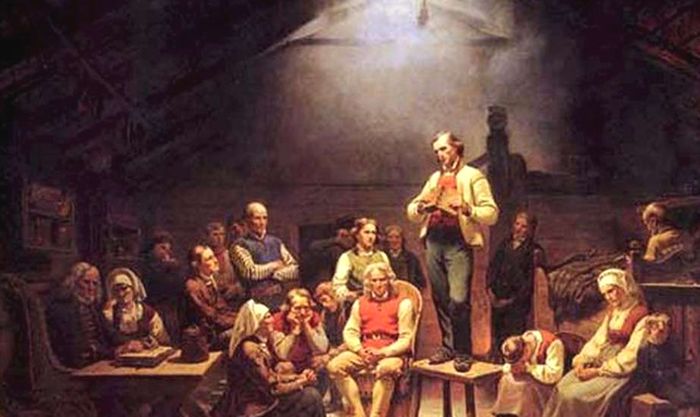
Pietism
The Inspirationist beliefs attracted many followers, and congregations were established throughout Germany and surrounding regions. Because Inspirationists declined to perform military duty, take state-required oaths, or send their children to church-run schools, the congregations often conflicted with church and governmental authorities. Many members of the Community of True Inspiration were punished with fines, imprisonment, and public beatings. Nevertheless, the Inspirationist movement flourished through the mid-18th century. However, by 1750, both Rock and Gruber were dead, and the movement declined and faded in the midst of European wars and economic depression.
War and famine, compounded by sweeping social and economic changes, devastated Germany in the early 1800s. Farmers and craftspeople were affected by high rents, taxes, and a new wave of industrialization. Many people, including a tailor named Michael Krausert, took comfort in religion. After studying the words of J.F. Rock in 1817, Krausert revitalized the Community of True Inspiration. He was soon joined by two others, Barbara Heinemann and Christian Metz. Metz emerged as the guiding force of the community during its crucial years of growth and relocation to America.
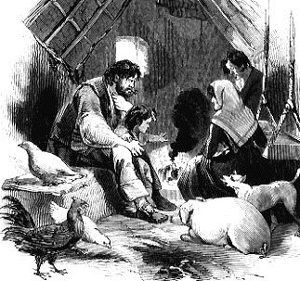
Peasant’s Cottage
During the 1820s and 1830s, Metz consolidated the community in the relatively liberal province of Hesse-Darmstadt in Germany. Congregations from Germany, Switzerland, and France moved to join the new communities in Hesse. The community leased large estates and castles within a few miles of each other. Both rich and poor lived together and shared in the social and economic life of the group. Although not communal, this arrangement helped to predispose the Inspirationists to the formal communal system which would be established in America and Amana.
By 1840 there were nearly 1000 members of the Community of True Inspiration, many living on the estates in Hesse. This growth took place in spite of persecution from German officials. The government, closely tied to the Lutheran church, viewed the Community’s theology as a political threat. Even in Hesse, Inspirationists were fined for their refusal to send children to state schools. Rising costs and several years of drought aggravated the conditions on the estates, causing Metz and other leaders to realize that they must seek a new home for the community.
In September 1842, a committee led by Christian Metz traveled to America in search of land on which to relocate the Community of True Inspiration. They purchased a 5,000-acre site near Buffalo, New York. By the end of 1843, nearly 350 Inspirationists had immigrated to the new settlement, which they named “Ebenezer,” meaning “hitherto hath the Lord helped us.”
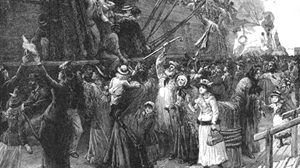
Immigration
From the start, in order to facilitate all members of the community to come to America and live together, all property in Ebenezer was held in common. The initial plan was that after some time, the land would be divided among the people according to their contribution of money and labor. However, leaders saw that the disparity in wealth, skills, and age would make it difficult for all to purchase a portion of land, and the community would fall apart as a result. Therefore, in 1846, a constitution was adopted, which established a permanent communal system. Any debate on this was resolved when Metz spoke a divine pronouncement endorsing the communal system.
Ebenezer flourished. By 1854 the population reached 1,200 people. Six villages were established, each with mills, shops, homes, communal kitchens, schools, and churches. To accommodate this growth, additional land was purchased, but more was needed. However, the booming growth of nearby Buffalo put land prices at a premium. In addition, the community leaders perceived a threat from the economic development around them. It was felt that capitalist and worldly influences were bringing about a growing interest in materialism and threatened the spiritual focus of the Inspirationist community. The leadership decided it was time to move the community again – this time to the unsettled West.
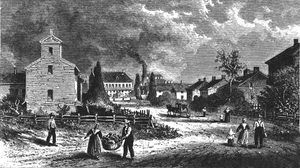
Historic Amana, Iowa
After investigating sites in Kansas and Iowa, the True Inspirationists selected a location along the Iowa River Valley about 20 miles west of Iowa City, Iowa to relocate their community. This site offered extensive timberland, quarries for limestone and sandstone, and long stretches of prairie filled with rich, black soil. Construction of the first village began in the summer of 1855, and the new settlement was named “Amana,” meaning “believe faithfully.” Community members moved to Amana over the next ten years as they gradually sold parcels of the Ebenezer property. A new constitution was adopted as the Community of True Inspiration took on the legal identity of the Amana Society. This new constitution essentially retained the communal system which had been developed in Ebenezer.
All members of the community shared in its economic success. The community provided each family with a home and all necessities of life. No one received a cash income. Rather, everyone was given an annual purchase allowance at the general store, where goods were priced at cost. Medical care was provided free by the community. In return, each person was expected to work and was assigned a job by the community Elders based on the needs of the community, as well as the talents of the individual. Nearly all women, starting at about age 14, worked in the communal kitchens and gardens. Women also tended to laundry, sewing, and knitting, and a few worked at the woolen mills. Men’s jobs were far more varied. Young men might learn to work in one of the many craft shops, in the mills, or on the farms. Some men were sent outside the community to be educated as doctors or pharmacists.
By the 1860s, the Amana Colony, as it came to be known, consisted of over 20,000 acres of land on which seven villages had been established. The villages were spaced just a few miles apart, roughly in the shape of a rectangle, and were named according to their location: West Amana, South Amana, High Amana, East Amana, and Middle Amana, in addition to the original village of Amana. The town of Homestead, little more than a few buildings, was purchased by the Inspirationists so that they could have a depot on the new railroad line.
Amana villages each consisted of 40 to 100 buildings. The barns and agricultural buildings were always clustered at the village edge. Orchards, vineyards, and gardens encircled the villages. Typical houses were rectangular two-story buildings of wood post-and-beam construction, brick, or sandstone. Each village had its own church, school, bakery, dairy, wine cellar, craft shops, and general store. There were also a number of communal kitchens in each village where groups of about 30-40 people ate their meals.
Although all Amana villages are similar, each has its distinctive aspects. The original village of Amana, for example, is reminiscent of a German town with its meandering main street and side streets. On the other hand, the last village built — Middle Amana — displays a very American square block layout. South Amana is known for its predominance of brick construction–boasting even a brick granary and chicken house; in West Amana and High Amana, sandstone buildings prevail. Tiny East Amana was not much more than an agricultural outpost, while Amana hummed with industry. The railroads’ influence on the villages is evident in Homestead’s single street and the split in South Amana — upper and lower.
The Amana settlement pattern of seven villages allowed the Inspirationists to access all their farmland easily. Just as importantly, it avoided a large urban setting which they felt encouraged immorality. Still, the network of small villages maintained an overall unity and kept everyone close to spiritual leadership.
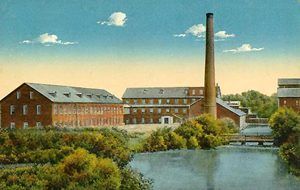
Amana, Iowa Woolen Mill
The Inspirationists established mills and shops according to their old-world skills. Amana’s woolen and calico factories were among the first in Iowa and quickly gained a national reputation for superior quality goods. The Inspirationists did not avoid using new technologies and, in fact, are known to have contributed innovations of their own to the textile industry. By 1908, the two woolen mills (in Amana and Middle Amana) were producing about a half-million yards of fabric a year, and the calico factory printed 4,500 yards of its famous cloth each day. Two flour mills (in West Amana and Amana) processed the community’s own small grains and those of neighboring farmers. Crops of potatoes and onions were shipped to Midwest markets. Profits from the mills and farms were used to purchase goods from outside the community.
Of course, for the Inspirationists, all this economic activity was subordinate to their religious purpose, to live a godly and pious life. To assist them in this, church services were held 11 times a week: every evening, Wednesday, Saturday, Sunday mornings, and Sunday afternoons. The Community also observed Easter, Christmas, and other Christian holidays. In addition, the Inspirationists in Amana held several special services during the year. Of these, the annual renewal of the covenant between each member and the community and Holy Communion were the most important. Holy Communion was actually held at times determined through inspiration until the death of Metz in 1867 and thereafter, usually every other year. A yearly spiritual examination was held over several months, with the Elders visiting each village in turn. Each community member came before the Elders and was questioned regarding his/her spiritual condition and admonished to lead a more pious life.
The church Elders, always men, comprised the leadership in the community and conducted the church services in each village. Some Elders were chosen as Trustees who managed the economic aspects and daily life of the villages. Up to this level, each village functioned independently. Collectively, the villages were governed by a Board of Trustees, 13 Elders elected by the adult members of the community. This board directed the overall affairs of the community. Following the death of Barbara Heinemann Landmann, the last Werkzeug, in 1883, the elders and Trustees functioned for nearly 50 years without the support of divine authority. They showed a remarkable degree of flexibility to allow communal Amana to become one of America’s longest-lived communal societies.
Though The Community of True Inspiration is more than 300 years old, the Amana of today differs from that of a century before. By the 1930s, the communal system in Amana had generated stresses which it could not resolve. Many community members found the rules associated with communal living to be petty and overly restrictive. Regulations governed most aspects of daily life, including dining, dress, and leisure activities. Many young people wanted to be free to play baseball, own musical instruments, or bob their hair in the new style. Families wanted to eat together at home rather than in the communal kitchen dining rooms. Although members received an annual spending allowance, many people felt theirs was inadequate and were frustrated by their inability to enjoy more material goods. Increasingly the elders were unable to enforce the rules.
In 1931, the community found itself in a crisis. In addition to the social strains of communal living, the community had suffered several economic setbacks in the previous decade. The Amana Society lost an important source of revenue when its calico print works closed after World War I. A fire in 1923 extensively damaged the woolen mill and completely destroyed the Amana flour mill. And the national economic depression had shrunk the market for the Society’s agricultural products.
The Elders presented the community members with a choice: either they could return to a more austere and disciplined life, or they could abandon the communal system. Significantly, the dissolution of the church was not considered as an alternative. But most members also recognized that their community had changed and that they were probably incapable of returning to the strict life of early communalism. Many people no longer equated their faith with the social mores dictated by the Community. Furthermore, many members felt that communalism itself was no longer a necessary tenet of the church’s faith. On June 1st, 1932, the members elected to retain the traditional church as it was and to create a joint-stock company (Amana Society, Inc.) for the business enterprises to be operated for profit by a Board of Directors [Use of American currency began January 15, 1933]. This separation of the church from the economic functions of the community — the abandonment of communalism — is referred to by Amana residents still today as “the Great Change.”
Today, the Amana Society, Inc., corporate heir to the land and economic assets of communal Amana, continues to own and manage some 26,000 acres of farm, pasture, and forest land. Agriculture remains an important economic base today, just as it was in communal times. Because the land was not divided up with the end of communalism, the landscape of Amana still reflects its communal heritage. In addition, over 450 communal-era buildings stand in the seven villages as vivid reminders of the past.
The most widely known business that emerged from the Amana Society is Amana Refrigeration, Inc. An Amana native founded this national leader in the production of refrigerators, George C. Foerstner, at the time of the Great Change. The first beverage cooler, designed for a businessman in nearby Iowa City in 1934, was built by skilled craftsmen at the Middle Amana woolen mill. In the following decades, the mill became the site of this large, now private, plant-producing refrigerators, freezers, and air conditioners, and in 1967 introduced a new product — the Amana Radarange Microwave Oven. Today, the 19th-century woolen mill smokestack still rises over the modern plant.
The Amana Church continues to be a vital part of the Amana community. These churches are much as they were when built more than 125 years ago. The building exteriors are unpretentious, with no steeples or stained-glass windows.
The interiors continue to feature unfinished wood floors, plain pine benches, and unadorned walls that have long echoed the tradition of humility and piety. Men still enter and sit on one side of a central aisle, women on the other.
English language services were introduced in 1960, but, in both German and English services, the order of worship has changed little over the years, which includes a reading from Scripture; a reading from testimony from Rock, Metz, or Landmann; and hymns that would be recognized by a congregation of a century earlier.
Today, heritage tourism has become important to the economy of the Amana area. Historic preservation efforts by several local nonprofit organizations, as well as the Amana Society, Inc., in conjunction with land-use and historic preservation ordinances, attempt to preserve the natural and built environment of Amana.
Visitors can stroll through Amana, the largest of the seven villages, and visit the Amana Woolen Mill and Amana Furniture Shop, which was originally a calico mill. Touring the other villages by car, visitors will pass through historic farmland and observe the imprint the colonists made on their landscape at places such as the Mill Race, a canal dug to provide waterpower for the mills, the Lily Lake, and groves of trees called Schulwalds. Barns and agricultural buildings were clustered together at the edge of each village; examples of this can be seen in West Amana, South Amana, and High Amana.
Each village contained numerous dwellings, such as those in Homestead. Groups of about 30-40 people ate their meals at one of several village kitchens, like one in Middle Amana which is now the Communal Kitchen Museum. Adjacent to this building is Hahn’s Hearth Oven Bakery, one of the several village bakeries that supplied fresh bread to the kitchens daily, and the Coopershop Museum, an example of the many trade buildings that were vital to daily life in Amana.
Every village also had a general store, such as those in High Amana and West Amana, and a school for children ages 7-14. But of course, the focus of the colonists’ lives was their religion, and a church was an essential element of each village where services were held 11 times a week. The Amana Colonies have long been a popular destination for tourists who were interested in learning about communal life. Several of these historic hotels and other historic communal buildings continue to offer lodging today, including the Die Heimat Country Inn, Lower South Hotel, and the Baeckerei Bed and Breakfast.
Compiled and edited by Kathy Alexander/Legends of America, updated July 2023.
Also See:
Sources:

